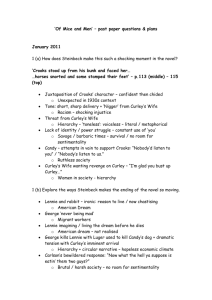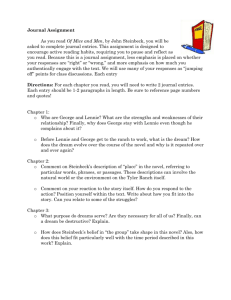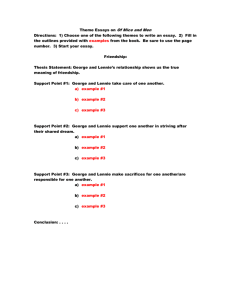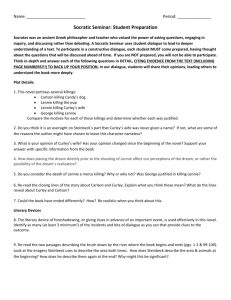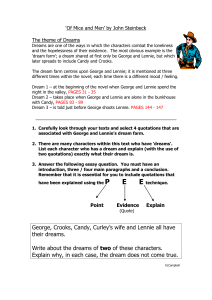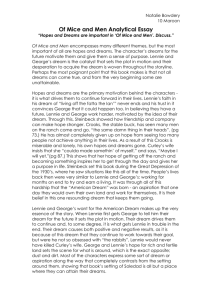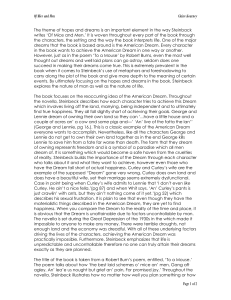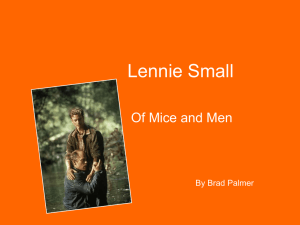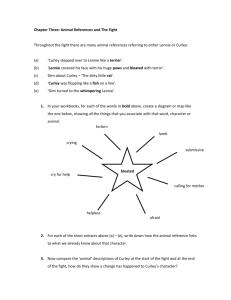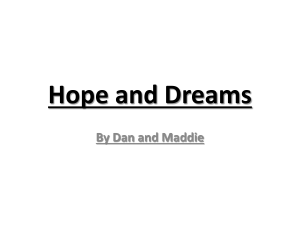Throughout the book, the idea of the American Dream reverberates
advertisement
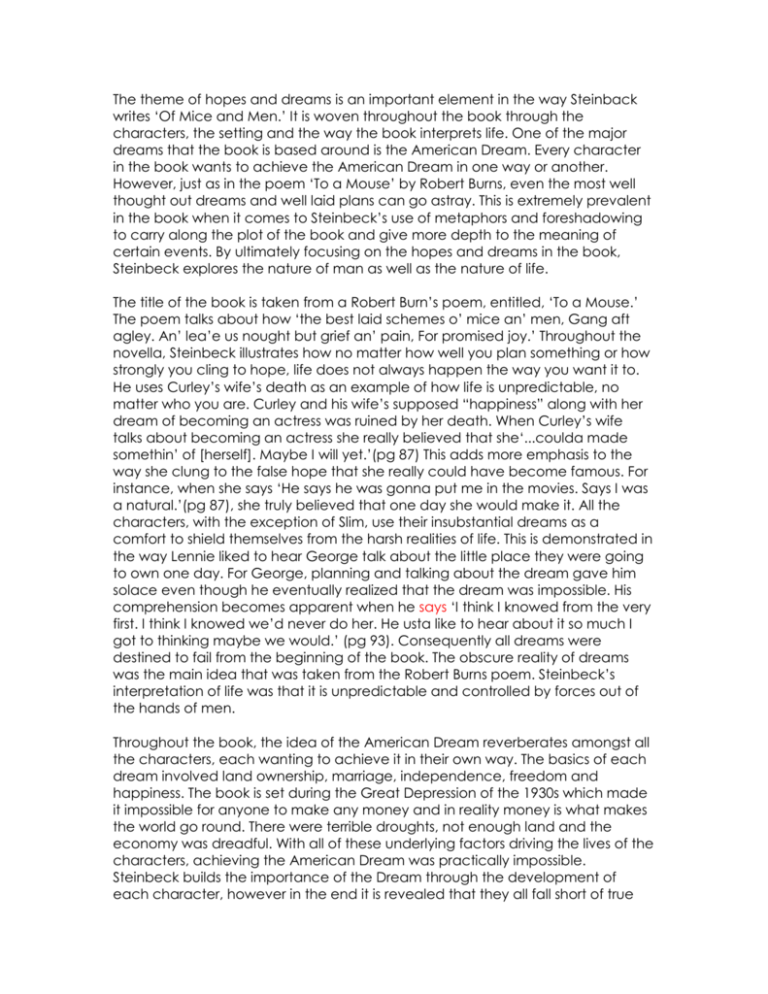
The theme of hopes and dreams is an important element in the way Steinback writes ‘Of Mice and Men.’ It is woven throughout the book through the characters, the setting and the way the book interprets life. One of the major dreams that the book is based around is the American Dream. Every character in the book wants to achieve the American Dream in one way or another. However, just as in the poem ‘To a Mouse’ by Robert Burns, even the most well thought out dreams and well laid plans can go astray. This is extremely prevalent in the book when it comes to Steinbeck’s use of metaphors and foreshadowing to carry along the plot of the book and give more depth to the meaning of certain events. By ultimately focusing on the hopes and dreams in the book, Steinbeck explores the nature of man as well as the nature of life. The title of the book is taken from a Robert Burn’s poem, entitled, ‘To a Mouse.’ The poem talks about how ‘the best laid schemes o’ mice an’ men, Gang aft agley. An’ lea’e us nought but grief an’ pain, For promised joy.’ Throughout the novella, Steinbeck illustrates how no matter how well you plan something or how strongly you cling to hope, life does not always happen the way you want it to. He uses Curley’s wife’s death as an example of how life is unpredictable, no matter who you are. Curley and his wife’s supposed “happiness” along with her dream of becoming an actress was ruined by her death. When Curley’s wife talks about becoming an actress she really believed that she‘...coulda made somethin’ of [herself]. Maybe I will yet.’(pg 87) This adds more emphasis to the way she clung to the false hope that she really could have become famous. For instance, when she says ‘He says he was gonna put me in the movies. Says I was a natural.’(pg 87), she truly believed that one day she would make it. All the characters, with the exception of Slim, use their insubstantial dreams as a comfort to shield themselves from the harsh realities of life. This is demonstrated in the way Lennie liked to hear George talk about the little place they were going to own one day. For George, planning and talking about the dream gave him solace even though he eventually realized that the dream was impossible. His comprehension becomes apparent when he says ‘I think I knowed from the very first. I think I knowed we’d never do her. He usta like to hear about it so much I got to thinking maybe we would.’ (pg 93). Consequently all dreams were destined to fail from the beginning of the book. The obscure reality of dreams was the main idea that was taken from the Robert Burns poem. Steinbeck’s interpretation of life was that it is unpredictable and controlled by forces out of the hands of men. Throughout the book, the idea of the American Dream reverberates amongst all the characters, each wanting to achieve it in their own way. The basics of each dream involved land ownership, marriage, independence, freedom and happiness. The book is set during the Great Depression of the 1930s which made it impossible for anyone to make any money and in reality money is what makes the world go round. There were terrible droughts, not enough land and the economy was dreadful. With all of these underlying factors driving the lives of the characters, achieving the American Dream was practically impossible. Steinbeck builds the importance of the Dream through the development of each character, however in the end it is revealed that they all fall short of true happiness. For George and Lennie the dream involved owning their own land so they could ‘...have a little house and a couple of acres an’ a cow and some pigs and—’ ‘An’ live of the fatta the lan’’ (pg 16). The farm that George and Lennie dreamed of owning represented freedom and was a symbol of a paradise to which all men aspire. It would become their own safe haven from the cruelties of reality. Their aspiration of buying their own farm is ruined when, in the end, George must kill Lennie. From the beginning of the book, doubt surrounded the outcome of the two men’s dream. As the reader, you were led to believe that their dream had no hope of ever being accomplished. Yet the two men believed in their fantasies with all their hearts. In contrast to George and Lennie’s aspirations, Curley and his wife were much the opposite. Curley and his wife were perceived to already have the dream as they owned land and were “happily” married; however their version of the American Dream had gone slightly awry. They already had all the things the two men had dreamed of-land, marriage and supposed joy-but in reality their marriage was very dysfunctional and they were obviously not content. The case in point being when Curley’s wife admits to Lennie that ‘I don’t even like Curley. He ain’t a nice fella.’(pg 87) it is clear to see she was not comfortable in her marriage. When Whit talks about how ‘Curley’s pants is just crawlin’ with ants.’(pg 52) he is referring to Curley’s obvious sexual frustration. This is yet another example of the insecure dynamics of their relationship. From the outside looking in, people around Curley and his wife believed that they had it made; they had everything anyone had ever fantasized about. For the most part, Curley and his wife fooled themselves into believing that the American Dream had become their reality. Towards the final stages of the story, however, everything starts to unravel and we find that this is not the case. They were both missing the essential element of happiness in their lives. Curley’s wife held onto her dream to be an actress, giving her hope and comfort through the trial that was her present life with Curley. In the end none of these dreams are truly achieved, which just goes to show that you cannot judge a book by its cover. Steinbeck uses this to emphasize that life is unpredictable and uncontrollable; therefore no one can truly attain their dreams exactly as they are planned. Even from the very beginning of the book and through every decisive plot twist and turn, it becomes apparent that each character will not be able to achieve their dreams. All the visions and fantasies of the characters were destined to fail. To set the story up for its tragic ending, the author uses foreshadowing and metaphors. This gives the reader clues as to what is going to happen in the end and helps Steinbeck to express how he believes even the most well thought out dreams are fated to fail. The mouse and puppy that Lennie kill are both metaphors for the way in which Curley’s wife is murdered. When George talks about how ‘Lennie never done it in meanness’ (pg 93) he describes how Lennie did not know his own strength and therefore did not mean to hurt anybody. After talking about their dream, George tells Lennie to ‘hide in the brush’ (pg 17) if he gets into any trouble. This is an effective use of foreshadowing to show that something was bound to go wrong that will stop their dream from coming true. Candy’s dog’s death is parallel to Lennie’s fate. In turn this was a metaphor for the fate of all the characters aspirations. The way Carlson kills the dog shows that those who are stronger will dispose of those who are weaker, in the same way that the bigger forces of life will dispose of the fragile dreams of man. Throughout the book George and Lennie’s dream becomes contagious, with Crooks and Candy cottoning on and borrowing some of the hope and comfort from the idea that they might actually make it. This helps to increase the impact of the stories tragic ending, by making you start to believe that their dreams might actually be fulfilled. All of these things relate to the way that foreshadows and metaphors are laced throughout the crucial plot points of the novella to help the reader understand Steinbeck’s view on the dreams of the characters. The way the characters each use their hopes and dreams to comfort them through reality is an important motif when it comes to the way Steinbeck describes the nature of men and their ‘well laid schemes’. The American Dream is the main dream that the characters all aspire to achieving. They each want to find their own piece of happiness in the cruel reality of the world. The poem from which the book takes it title has an obvious influence on these ideals. Life does not always happen as it is planned no matter what you do or who you are. Through metaphors, Steinbeck shows that fate and destiny are very different to dreams and the outcomes of life. Man’s fate is guided by bigger forces, therefore dreams, even though they may comfort you in the present, may only give false hope as to what you can really achieve.
